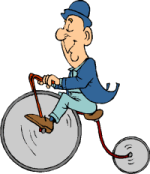
The Past
English has three main tenses – the past, the present and the future. As you might expect, the past tense is used to describe events that happened before the present. As you probably also expect by now from English, things are a not that straightforward. For a start like the other English tenses, the past tense (which you will find described as the 'preterite' in some older textbooks), has aspects, a voice and a mood. This might seem complicated, but the result is that by matching and combining mood, voice and aspect, we are able to describe the past very precisely.
So let us go through these ways of describing the past one by one.
Past Simple The past simple would be more simple if it did not have a negative and a positive form.
Consider -
I painted the ceiling yesterday.
I did not paint the ceiling yesterday.
As you can see, in the positive the main verb takes a unique form and does not use an auxilliary. With 'regular' verbs this form is made by adding '-ed' to the end of the verb. (e.g. 'Paint-ed'). Just to complicate things, this simple past form is often the same as the past participle of the verb, even though the past participle has a different function.
Finally, past simple positive verbs can be irregular – and the more commonly a verb is used, the more likely it is to be irregular. Sometimes the irregular form is the same as the past participle, and sometimes it is not.
For example -
take (infinitive), took (unique simple past form), taken (past participle).
The good news is that irregular verbs are regular in the negative.
For example -
He took my pen. (irregular)
He did not take my pen. (regular)
Past Progressive This is also sometimes called the 'Past Continuous'. It tells you what was happening at the same time as another action in the past.
For example: I was sleeping when you called.
In this sentence 'called' is simple past, and the main verb is past progressive formed from the auxiliary 'to be' in the past form ('was/were') and the present participle of the verb. (Sometimes called the -ing form; here 'sleeping'.) Unlike the past simple, the negative form of the progressive is identical apart from the addition of the negative indicator.
I was not sleeping when you called.
Usually the progressive is used with a time indicator, often another verb, which tells us when the progressive action was happening. In the example above the time indicator is 'when you called'. However it can also be a time or a situation.
For example:
I was sleeping at two o'clock.
It was hot while I was sleeping.
Note also, that usually we put the most important part of the sentence first. So if the important thing in the first example was that someone called, that would come first.
When you called, I was sleeping.
But if the important thing is your interrupted sleep, that comes first.
I was sleeping when you called.
The Perfect The two other aspects of the past are the Past Perfect and the Perfect Progressive, which are described in our section on the Perfect. https://www.english-online.org.uk/adv6/adv1_6.htm, if you need to review these.) Remember though, that while the Present Perfect seems to be a past tense, it is actually as the name says – a present.
Consider -
He has already watered the plants.
Even though the plants were watered in the past, this is a present tense because the present condition of the plants is that they are now watered. This only becomes a past tense when the plants dry out and we can say.
He watered the plants.(But now he has to do it again!)